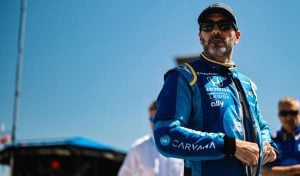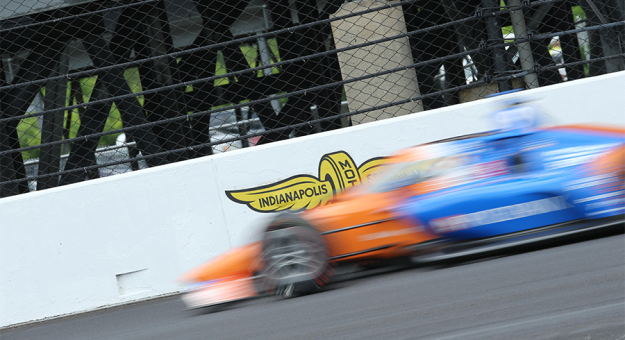INDIANAPOLIS – If last week’s pole qualifications were a showcase of speed, Sunday’s 106th Indianapolis 500 will be determined by the driver and teams that are best able to adapt to changing conditions.
Sunday’s race day temperature is expected to be in the mid-to high-80s, which means the dark black asphalt will become greasy and slick. Teams will have to factor in how much downforce is needed at the start of the race and then either add more, or free up the car later in the race as the surface changes.

“With the sealer they put on the track for this year, it has increased the speed and grip level for tire management, and it definitely changed,” said defending and four-time Indianapolis 500 winner Helio Castroneves of Meyer-Shank Racing. “There are a lot of details that are known and unknown at this point.
“The speeds are higher, but in the race, you slow down from the practice. A hot track becomes more slippery, and that is what we will have. If those conditions happen, whoever has a good setup will be outstanding out there.”
Chasing track conditions is a key, according to Castroneves’ teammate, 2019 Indy 500 winner Simon Pagenaud.
“It’s been an up-and-down weather week and very difficult to understand,” Pagenaud said. “When the track reaches a certain temperature, the car starts sliding. You saw that in qualifying as the tires start sliding after two or three laps.
“We have to push that threshold as far as we can and be ready for that point. Come race day, it’s going to be 85 degrees with track temp in the 120s. It’s going to be an interesting choice and game to play because being fast at the end of the race is very important.
“It’s been a mind game to figure out all of those temperatures.”
Although qualification speeds included the fastest Indy 500 pole speed in history with Scott Dixon’s four-lap average of 234.046 miles per hour, that was with extra boost added to the car for Fast Friday and qualification weekend.
Dixon’s speed broke the Indianapolis 500 pole record of 233.718 mph set by Scott Brayton in 1996. Arie Luyendyk’s all-time four-lap qualifying average speed of 236.986 mph in 1996 came on the second day of qualifications and was not eligible for the pole.
Qualifying setup has little to do with the setup for the race, other than determine the starting position of the 33-car starting lineup.

Castroneves and his “Drive for Five” are just one of the many storylines in Sunday’s 106th Indianapolis 500. It’s the first time since 2019 that the race will be held with full capacity and the largest crowd since the 100th Indianapolis 500 in 2016 is expected.
Spectators were not allowed in the facility because of COVID-19 in 2020 and last year’s crowd was limited to 137,000.
Only a few thousands tickets are left for sale, mostly in the north short chute, according to Indianapolis Motor Speedway President Doug Boles. The Indianapolis Motor Speedway has 238,000 grandstand seats with another 5,000 fans allowed in the infield.
Dixon won his fifth pole of his career last Sunday and he is attempting to win the Indianapolis 500 for the second time. He drove to victory from the pole in 2008.
“I’m as determined as ever,” Dixon said. “The longer you come to this place, and you have four or five second-place finishes and three of those have been under caution, those are the ones that hurt the most because you couldn’t even fight for it. One of those was a given if it had run its full course.
“Those suck.
“But that is also what keeps the fire really strong. Those close misses keep you up and night and anger you, too.
“This place owes me nothing. I love coming here. It’s a privilege coming here and I’m very lucky coming with one of the best teams in the sport.
“We’ll keep digging. We’ll keep knocking on the door and one day, hopefully it opens.
“Maybe one day, maybe one day I’ll get my second.”
Dixon leads a five-driver team for Chip Ganassi Racing in this year’s Indianapolis 500. Teammate and defending NTT IndyCar Series champion Alex Palou starts second in the No. 10 NTT DATA Honda. Marcus Ericsson starts fifth in the No. 8 Huski Chocolate Honda, Tony Kanaan is sixth in the No. 1 American Legion Honda and seven-time NASCAR Cup Series champion and Indy 500 rookie Jimmie Johnson starts 12th in the No. 48 Carvana/American Legion Honda.

Johnson is a major storyline because the four-time Brickyard 400 winner at Indianapolis Motor Speedway in NASCAR has been very impressive in practice and qualifications on the IMS oval.
“I’m absolutely looking forward to it,” Johnson said. “Being here last year to watch as a fan, take it all in, the energy I experienced was not anything like I’ve seen before. It was only half full. I can’t wait until race day to feel it at full energy.
“Each day we get closer to the 500, it gets busy. The pressure is ramping up. I think the weekend was quite busy with qualifying. I didn’t anticipate that; the stress demands each driver would take.
“Some of it’s predictable with media and trying to promote this big race, be a part of it. It is odd to have tomorrow off and not be in the car at all, then just get in on Sunday.
“Again, just kind of roll with it and take in everything I can.”
Another fast rookie driver is Roman Grosjean of Andretti Autosport. The former Formula One driver starts ninth in the No. 28 DHL Honda.
“My kids are coming in Saturday evening,” Grosjean said. “I’m wanting them to be here for my first 500. Actually Monday, they may skip school on Tuesday. At least we get to spend a little bit of time together before we go to Detroit. That’s cool.”
Rinus VeeKay starts on the outside of row one and the 21-year-old has a chance to break a 70-year-record held by Troy Ruttman as the youngest winner in the Indianapolis 500. Ruttman was 22 when he won in 1952.
Two-time Indianapolis 500 winners include Juan Pablo Montoya (2000 and 2015) and Takuma Sato (2017 and 2020). If either driver wins on Sunday, they will become the first three-time winners that won each of their three victories with three different teams.
There are many, many more storylines in Sunday’s 106th Indianapolis 500 and by the end of the race, some may play out to realization.
Or a completely unexpected storyline could develop out of nowhere.
That is what makes the Indianapolis 500 so unique and so dramatic.
